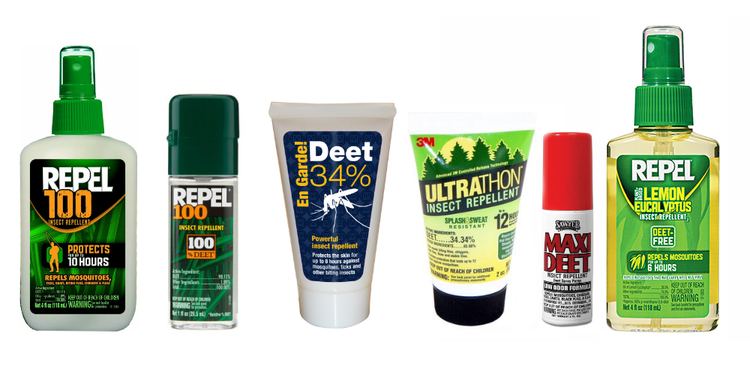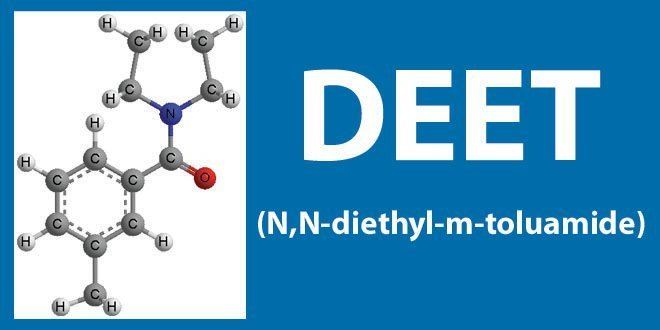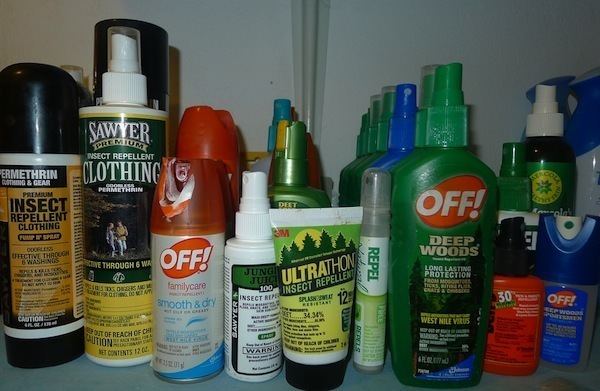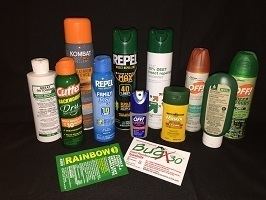Formula C12H17NO Boiling point 288 °C Melting point -45 °C | Molar mass 191.27 g/mol Density 998 kg/m³ | |
 | ||
IUPAC ID N,N-Diethyl-3-methylbenzamide | ||
Deet
N,N-Diethyl-meta-toluamide, also called DEET (/diːt/) or diethyltoluamide, is the most common active ingredient in insect repellents. It is a slightly yellow oil intended to be applied to the skin or to clothing, and provides protection against mosquitoes, ticks, fleas, chiggers, leeches, and many biting insects.
Contents
- Deet
- History
- Preparation
- Mechanism and effectiveness
- Concentrations
- Effects on health
- Detection in body fluids
- Effects on materials
- Effects on the environment
- References

History

DEET was developed in 1944 by Samuel Gertler of the United States Department of Agriculture for use by the United States Army, following its experience of jungle warfare during World War II. It was originally tested as a pesticide on farm fields, and entered military use in 1946 and civilian use in 1957. It was used in Vietnam and Southeast Asia.

In its original form known as "bug juice", the application solution for DEET was composed of 75% DEET and ethanol. Later, a new application of the repellant was developed by U.S. Army and the USDA consisted of DEET and other polymers that extended the release of the DEET and reduced its evaporation rate. This extended release application was registered by the EPA in 1991.
Preparation

A slightly yellow liquid at room temperature, it can be prepared by converting m-toluic acid (3-methylbenzoic acid) to the corresponding acyl chloride, and allowing it to react with diethylamine:
Mechanism and effectiveness

DEET was historically believed to work by blocking insect olfactory receptors for 1-octen-3-ol, a volatile substance that is contained in human sweat and breath. The prevailing theory was that DEET effectively "blinds" the insect's senses so that the biting/feeding instinct is not triggered by humans or other animals which produce these chemicals. DEET does not appear to affect the insect's ability to smell carbon dioxide, as had been suspected earlier.

However, more recent evidence shows that DEET serves as a true repellent in that mosquitoes intensely dislike the smell of the chemical. A type of olfactory receptor neuron in special antennal sensilla of mosquitoes that is activated by DEET, as well as other known insect repellents such as eucalyptol, linalool, and thujone, has been identified. Moreover, in a behavioral test, DEET had a strong repellent activity in the absence of body odor attractants such as 1-octen-3-ol, lactic acid, or carbon dioxide. Both female and male mosquitoes showed the same response.
A 2011 structural study (PDB: 3N7H) revealed that DEET binds to Anopheles gambiae odorant binding protein 1 (AgamOBP1) with high shape complementarity, suggesting that AgamOBP1 is a molecular target of DEET and perhaps other repellents.
A 2013 study suggests that mosquitoes can at least temporarily overcome or adapt to the repellent effect of DEET after an initial exposure, representing a non-genetic behavioral change. This observation, if verified, has significant implications for how repellent effectiveness should be assessed.
A highly conserved protein member of the ionotropic receptor family, IR40a, has recently been identified as a putative DEET receptor in the fly antenna. The neurons expressing IR40a respond to DEET in an IR40a dependent manner. Avoidance to DEET vapors is lost in flies that lack IR40a. Other repellent chemicals that are structurally related to DEET also activate the same receptor and repel mosquitoes and flies, suggesting that this receptor can be used to screen for new repellents.
The hypothesis that IR40a is involved in DEET reception in mosquitoes has been tested in the southern house mosquito, Culex quinquefasciatus. Reducing CquiIR40a transcript levels did not affect DEET-elicited behavior or electroantennographic (EAG) responses thus suggesting that IR40a is not involved in DEET reception in Culex mosquitoes. An antennae-specific odorant receptor, CquiOR136, was demonstrated to respond to DEET and other insect repellents. Similar knockout experiments showed that EAG responses to DEET recorded from mosquitoes with reduced CquiOR136 transcript levels were dramatically lower. Additionally, behavioral tests showed that this phenotype was not repelled by DEET. In conclusion, these results suggest that CquiOR136, not CquiIR40a, is involved in DEET reception in the southern house mosquito.
Concentrations
DEET is often sold and used in spray or lotion in concentrations up to 100%. Consumer Reports found a direct correlation between DEET concentration and hours of protection against insect bites. 100% DEET was found to offer up to 12 hours of protection while several lower concentration DEET formulations (20%-34%) offered 3–6 hours of protection. Other research has corroborated the effectiveness of DEET. The Centers for Disease Control and Prevention recommends 30-50% DEET to prevent the spread of pathogens carried by insects.
Effects on health
As a precaution, manufacturers advise that DEET products should not be used under clothing or on damaged skin, and that preparations be washed off after they are no longer needed or between applications. DEET can act as an irritant; in rare cases, it may cause severe epidermal reactions. Other symptoms that can occur are breathing difficulty, burning eyes, headaches.
In the DEET Reregistration Eligibility Decision (RED) in 1998, the United States Environmental Protection Agency (EPA) reported 14 to 46 cases of potential DEET-associated seizures, including 4 deaths. The EPA states: "... it does appear that some cases are likely related to DEET toxicity," but observed that with 30% of the US population using DEET, the likely seizure rate is only about one per 100 million users.
The Pesticide Information Project of Cooperative Extension Offices of Cornell University states that "Everglades National Park employees having extensive DEET exposure were more likely to have insomnia, mood disturbances and impaired cognitive function than were lesser exposed co-workers".
When used as directed, products containing between 10% and 30% DEET have been found by the American Academy of Pediatrics to be safe to use on children, as well as adults, but recommends that DEET not be used on infants less than two months old.
Citing human health reasons, Health Canada barred the sale of insect repellents for human use that contained more than 30% DEET in a 2002 re-evaluation. The agency recommended that DEET-based products be used on children between the ages of 2 and 12 only if the concentration of DEET is 10% or less and that repellents be applied no more than 3 times a day, children under 2 should not receive more than 1 application of repellent in a day and DEET-based products of any concentration should not be used on infants under 6 months. Some experts recommend against applying DEET and sunscreen simultaneously since that would increase DEET penetration; Canadian researcher, Xiaochen Gu, a professor at the University of Manitoba’s faculty of Pharmacy who led a study about mosquitos, advises that DEET should be applied 30 or more minutes later. Gu also recommends DEET sprays instead of lotions which are rubbed into the skin "forcing molecules into the skin".
DEET is commonly used in combination with insecticides and can strengthen the toxicity of carbamate insecticides, which are also acetylcholinesterase inhibitors. These findings indicate that DEET has neurological effects on insects in addition to known olfactory effects, and that its toxicity is strengthened in combination with other insecticides.
Detection in body fluids
DEET may be quantitated in blood, plasma or urine by gas or liquid chromatography-mass spectrometry to confirm a diagnosis of poisoning in hospitalized patients or to provide evidence in a medicolegal death investigation. Blood or plasma DEET concentrations are expected to be in a range of 0.3-3.0 mg/L during the first 8 hours after dermal application in persons using the chemical appropriately, >6 mg/L in intoxicated patients and >100 mg/L in victims of acute intentional oral overdose.
Effects on materials
DEET is an effective solvent, and may dissolve some watch crystals, plastics, rayon, spandex, other synthetic fabrics, and painted or varnished surfaces including nail polish.
Effects on the environment
Though DEET is not expected to bioaccumulate, it has been found to have a slight toxicity for fresh-water fish such as rainbow trout and tilapia, and it also has been shown to be toxic for some species of freshwater zooplankton. DEET has been detected at low concentrations in water bodies as a result of production and use, such as in the Mississippi River and its tributaries, where a 1991 study detected levels varying from 5 to 201 ng/L.
